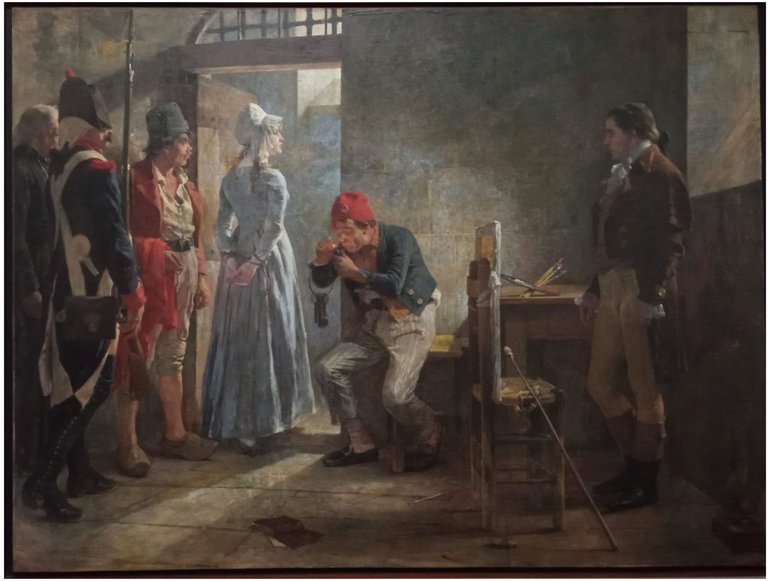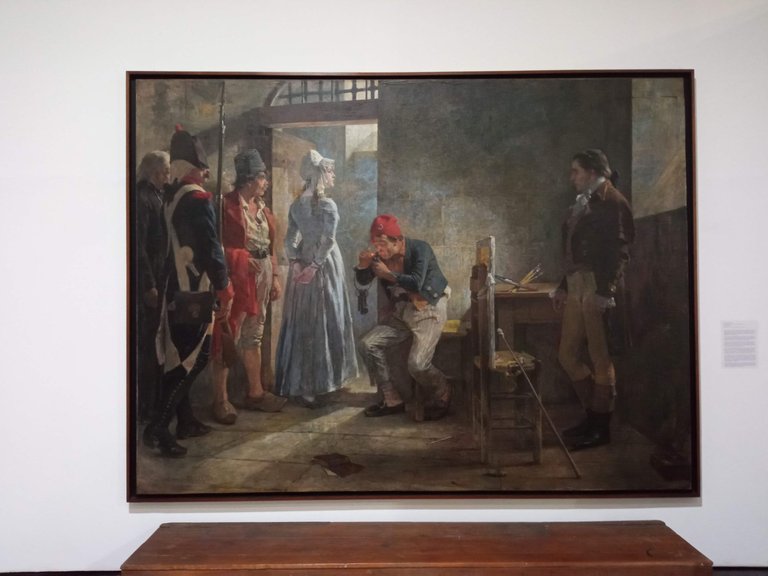
ESP
Estimada comunidad de Hive, hoy quiero presentarles una de las obras estelares de la pintura venezolana del siglo XIX, se trata de la pieza titulada Carlota Corday camino al cadalso, realizada en 1.889, por el artista Arturo Michelena (1.863-1.898). El tema central de esta composición se refiere a los últimos momentos de vida de Carlota Corday. Conocida como Marie-Anne-Charlotte Corday d'Armont, esta joven aristócrata nació en Normandía en 1.768, fue partícipe de la Revolución francesa (1.789-1.799), seguidora de los ideales del partido de los girondinos o moderados. Corday se hizo famosa por asesinar al activista Jean-Paul Marat, un político radical del sector de los jacobinos, quien acusaba cruelmente a los militantes de la Revolución, implementando así un régimen de terror. Con el fin de detener la persecución desatada por este personaje, ella lo apuñala en la bañera de su casa ocasionándole la muerte, el 13 de julio de 1.793. Ese mismo año ella fue capturada y ejecutada en la guillotina, con apenas veinticinco años de edad, el 17 de julio en la ciudad de París. A partir de ese suceso Corday es considerada una heroína de la Revolución.
Arturo Michelena interpreta el episodio colocando la imagen de Carlota Corday en camino hacia el cadalso. Al iluminar la parte frontal de su figura, portando un vestido de color azul claro, le da un carácter protagónico dentro del entorno sombrío que la rodea. La acompañan personal de guardia y carceleros, así como un sacerdote y un pintor retratista oficial, encargado de dejar testimonio visual de la prisionera, conocido como Jean-Jacques Hauer, representado a la derecha del cuadro. Michelena realizó esta obra con la tradicional técnica al óleo, con un tratamiento académico con el que este artista demostró maestría y talento. En cuanto a las dimensiones del cuadro, él utilizó un lienzo de 2.35 metros de alto por 3.15 metros de ancho, lo que le confiere un sentido de monumentalidad a la escena.
La obra Carlota Corday camino al cadalso, 1.889, participó en la “Exposición Universal Internacional”, un evento organizado por la República Francesa en 1.889, con el objeto de celebrar el Primer Centenario de la Revolución Francesa. Esta pintura obtuvo el mayor galardón en su categoría, que consiste en una medalla de oro en primera clase y un diploma de reconocimiento y acreditación. La obra fue llevada a Venezuela e ingresó a la colección del Museo de Bellas Artes de Caracas, creado en 1.917. Posteriormente, fue transferida a la Galería de Arte Nacional, en 1.977, donde regularmente es exhibida.
Arturo Michelena nació en la ciudad de Valencia, Estado Carabobo, Venezuela, en 1.863. Estudió pintura en París, Francia, en la Academia Julián, con el profesor Jean Paul Laurens. Recibió galardones como: Medalla de plata de la Exposición Nacional de Venezuela, 1.883, Medalla de segunda clase, Salón de artistas franceses, 1.887, Medalla de oro primera clase, Exposición Universal Internacional, 1.889, y Medalla de honor, Exposición Mundial Colombina, Chicago, 1.893. Arturo Michelena fallece en Caracas, Venezuela, en 1.898.
Gladys Yunes Yunes
Fotografía: Gladys Yunes Y.

ENG
Dear Hive community, today I would like to present one of the stellar works of 19th century Venezuelan painting, the piece entitled Carlota Corday on her way to the scaffold, created in 1889 by the artist Arturo Michelena (1863-1898). The central theme of this composition refers to the last moments of Carlota Corday's life. Known as Marie-Anne-Charlotte Corday d'Armont, this young aristocrat, born in Normandy in 1768, was a participant in the French Revolution (1789-1799), a follower of the ideals of the Girondin or moderate party. Corday became famous for assassinating the activist Jean-Paul Marat, a radical politician of the Jacobins sector, who cruelly accused the militants of the Revolution, thus implementing a regime of terror. In order to stop the persecution unleashed by this personage, she stabbed him in the bathtub of his house causing his death, on July 13, 1793. That same year she was captured and executed in the guillotine, with only twenty-five years of age, on July 17 in the city of Paris. Since that event Corday is considered a heroine of the Revolution.
Arturo Michelena interprets the episode by placing the image of Carlota Corday on her way to the scaffold. By illuminating the front of her figure, wearing a light blue dress, he gives her a protagonist character within the somber environment that surrounds her. She is accompanied by guards and jailers, as well as a priest and an official portrait painter, in charge of leaving visual testimony of the prisoner, known as Jean-Jacques Hauer, represented on the right of the painting. Michelena painted this work with the traditional oil technique, with an academic treatment with which this artist demonstrated mastery and talent. As for the dimensions of the painting, he used a canvas 2.35 meters high by 3.15 meters wide, which gives a sense of monumentality to the scene.
The work Carlota Corday on the way to the scaffold, 1889, participated in the “Exposition Universelle Internationale”, an event organized by the French Republic in 1889, in order to celebrate the First Centenary of the French Revolution. This painting obtained the highest award in its category, consisting of a gold medal in first class and a diploma of recognition and accreditation. The work was taken to Venezuela and entered the collection of the Museo de Bellas Artes de Caracas, created in 1917. Later, it was transferred to the National Art Gallery in 1977, where it is regularly exhibited.
Arturo Michelena was born in the city of Valencia, Carabobo State, Venezuela, in 1863. He studied painting in Paris, France, at the Julian Academy, with Professor Jean Paul Laurens. He received awards such as: Silver Medal at the National Exhibition of Venezuela, 1883, Second Class Medal, French Artists Salon, 1887, Gold Medal First Class, International Universal Exposition, 1889, and Medal of Honor, World Columbian Exposition, Chicago, 1893. Arturo Michelena died in Caracas, Venezuela, in 1898.
Gladys Yunes Yunes
Photograph: Gladys Yunes Y.
Una de mis obras preferidas de la pintura clásica venezolana, siempre me ha llamado la atención el personaje fumando, justo al centro de la composición, supongo que es el carcelero. Saludos!
¿ᴺᵉᶜᵉˢᶦᵗᵃˢ ᴴᴮᴰ? ᵀᵉ ˡᵒ ᵖʳᵉˢᵗᵃᵐᵒˢ ᶜᵒⁿ
Congratulations @yunesyunesarte! You have completed the following achievement on the Hive blockchain And have been rewarded with New badge(s)
Your next target is to reach 1500 upvotes.
You can view your badges on your board and compare yourself to others in the Ranking
If you no longer want to receive notifications, reply to this comment with the word
STOPCheck out our last posts:
Que maravillosa obra nos presenta, gracias por darme a conocer su historia, no estaba al tanto de lo heroica que fue Carlota Corday, me parece que represento mucho para el proceso de la revolución Francesa, gracias por este grandioso post.